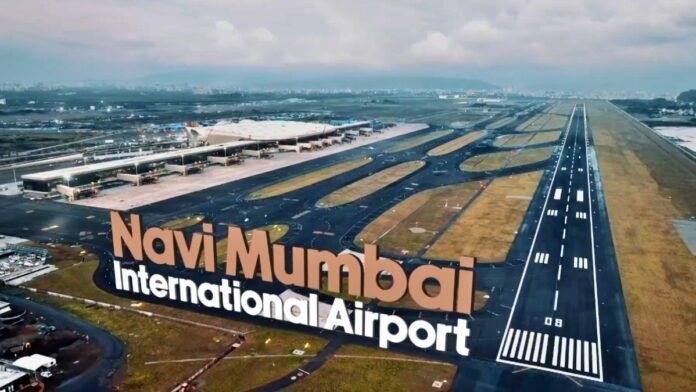
Key Points
- Prime Minister Narendra Modi inaugurated Phase 1 of Navi Mumbai International Airport (NMIA) on Wednesday, October 8, 2025
- Massive greenfield project built at cost of approximately ₹19,650 crore spread across 1,160 hectares
- Airport designed to ease congestion at Mumbai’s Chhatrapati Shivaji Maharaj International Airport (CSMIA), one of India’s busiest
- Phase 1 terminal capable of handling 20 million passengers annually; full capacity target of 90 million passengers per year
- Features India’s longest runway at 3,700 meters, capable of handling largest aircraft including Airbus A380
- Single runway initially operational; second parallel runway planned for future phases
- Project executed by City and Industrial Development Corporation (CIDCO) with GVK Group and Airports Authority of India
- Strategic location in Panvel-Ulwe area provides connectivity to Mumbai, Navi Mumbai, Thane, and Pune
- Airport designed as sustainability showcase with green building features and renewable energy integration
- Expected to generate over 100,000 direct and indirect employment opportunities in aviation and allied sectors
- Multi-modal connectivity planned including dedicated Metro line, expressway connections, and railway links
- Will position Mumbai Metropolitan Region as major aviation hub rivaling global cities
Mumbai: Prime Minister Narendra Modi on Wednesday, October 8, 2025, inaugurated Phase 1 of the Navi Mumbai International Airport (NMIA), marking a historic milestone for India’s aviation sector and fulfilling a decades-long aspiration to expand Mumbai’s air connectivity. The massive greenfield airport project, constructed at an estimated cost of approximately ₹19,650 crore and spread across an expansive 1,160 hectares, represents one of India’s most ambitious infrastructure initiatives and is poised to transform the Mumbai Metropolitan Region into a world-class aviation hub.
Addressing Mumbai’s Aviation Capacity Crisis
The inauguration of Navi Mumbai International Airport addresses a critical infrastructure bottleneck that has constrained Mumbai’s growth for years. Mumbai’s existing Chhatrapati Shivaji Maharaj International Airport (CSMIA), despite being one of India’s busiest and handling over 50 million passengers annually, has been operating near capacity for several years. The single-runway constraint and limited expansion possibilities due to Mumbai’s dense urban environment have created a pressing need for additional aviation infrastructure in the region.
NMIA will significantly ease the traffic burden on CSMIA by providing substantial additional capacity for both passenger and cargo operations. The new airport is strategically designed to complement rather than replace the existing airport, with the two facilities working in tandem to position the Mumbai Metropolitan Region as a major global aviation gateway capable of handling the growing demand from India’s economic powerhouse.
Phased Development and Capacity
The Navi Mumbai International Airport is being developed in multiple phases to optimize investment and align capacity with demand growth. Phase 1, inaugurated by Prime Minister Modi, includes a state-of-the-art passenger terminal capable of handling 20 million passengers annually. This initial capacity itself equals nearly 40% of CSMIA’s current annual passenger traffic, providing immediate and substantial relief to Mumbai’s aviation congestion.
The airport’s master plan envisions ultimate development to handle 90 million passengers per year, which would make it one of the highest-capacity airports in Asia. This ambitious capacity target reflects confidence in India’s aviation growth trajectory and Mumbai’s continued economic importance. Future phases will include expansion of terminal facilities, addition of parallel runways, dedicated cargo terminals, and supporting infrastructure to achieve the full design capacity.
World-Class Infrastructure and Facilities
Phase 1 of NMIA features cutting-edge aviation infrastructure designed to international standards. The airport boasts India’s longest runway at 3,700 meters, engineered to accommodate the largest commercial aircraft currently in operation, including the Airbus A380 superjumbo jet. This runway length also provides operational flexibility for fully-loaded long-haul flights to any global destination without payload restrictions.
The passenger terminal building incorporates modern architectural design with emphasis on passenger convenience, operational efficiency, and aesthetic appeal. Facilities include advanced baggage handling systems, comprehensive retail and dining options, business lounges, and amenities designed to provide a premium travel experience. The terminal design emphasizes natural lighting, spacious interiors, and intuitive passenger flow to minimize stress and confusion for travelers.
Initially, operations will commence with a single runway, with provisions in the master plan for a second parallel runway to be constructed in subsequent phases. This parallel runway configuration will eventually enable simultaneous operations that dramatically increase aircraft movement capacity and reduce delays.
Sustainability and Green Design
Recognizing global environmental concerns and India’s commitment to sustainable development, NMIA has been designed as a showcase for green airport operations. The project incorporates numerous sustainability features including extensive use of renewable energy through solar panels, rainwater harvesting systems to reduce water consumption, energy-efficient lighting and climate control systems, and green building materials that minimize environmental impact.
The airport’s design emphasizes reducing carbon footprint through optimized building orientation, natural ventilation where possible, and integration with public transportation to reduce private vehicle usage. These environmental initiatives position NMIA as a model for future airport development in India and demonstrate that large-scale infrastructure can be developed with environmental responsibility.
Strategic Location and Connectivity
The Navi Mumbai International Airport’s location in the Panvel-Ulwe area has been strategically selected to provide excellent connectivity to Mumbai, Navi Mumbai, Thane, Pune, and other major cities in Maharashtra. This location places the airport within convenient reach of the Mumbai Metropolitan Region’s population of over 25 million while avoiding the congestion and space constraints that limit expansion possibilities at the existing airport.
Comprehensive multi-modal connectivity plans are integral to NMIA’s success. A dedicated Mumbai Metro line will directly connect the airport to the city’s expanding metro network, providing fast and affordable access for passengers. Major expressways including the Mumbai-Pune Expressway and coastal roads will offer convenient road connectivity. Additionally, railway connections are planned to integrate the airport with Mumbai’s extensive suburban rail network and long-distance train services.
This multi-modal approach ensures that passengers from across the region can reach the airport efficiently while reducing traffic congestion and environmental impact associated with airport access.
Economic Impact and Employment Generation
The Navi Mumbai International Airport project represents far more than transportation infrastructure—it is a catalyst for comprehensive regional economic development. The airport is expected to generate over 100,000 direct and indirect employment opportunities across aviation operations, hospitality, retail, logistics, ground transportation, and supporting services.
Beyond direct airport-related employment, NMIA will stimulate broader economic activity in the surrounding region. The airport is expected to attract commercial development, logistics parks, hospitality facilities, and business centers that will create additional employment and economic opportunities. Real estate values in areas with improved airport connectivity are likely to appreciate, benefiting property owners and generating tax revenues for local governments.
For India’s aviation industry, NMIA provides capacity for airlines to expand operations, add new routes, and increase flight frequencies to existing destinations. This capacity expansion supports India’s growing aviation market, which has been among the world’s fastest-growing in recent years, driven by rising incomes, increasing business travel, and growing tourism.
Project Execution and Stakeholders
The Navi Mumbai International Airport has been developed by the City and Industrial Development Corporation (CIDCO), the planning and development authority for Navi Mumbai and the surrounding region. CIDCO has worked in partnership with the GVK Group, a major Indian infrastructure conglomerate with extensive experience in airport development and operations, and the Airports Authority of India (AAI), the government body responsible for airport infrastructure.
This public-private partnership model leverages government land acquisition capabilities and regulatory authority with private sector expertise in project execution, operations management, and commercial development. The partnership structure has enabled mobilization of the substantial capital required for the project while ensuring professional management and operational excellence.
National Aviation Strategy Context
The inauguration of Navi Mumbai International Airport aligns with Prime Minister Modi’s broader vision for transforming India’s aviation sector under the UDAN (Ude Desh ka Aam Naagrik) scheme and other initiatives aimed at expanding air connectivity and making air travel accessible to ordinary citizens. India has been developing new airports, modernizing existing facilities, and expanding regional connectivity as part of a comprehensive strategy to support economic growth and integrate the country’s diverse regions.
The Mumbai Metropolitan Region, as India’s financial capital and commercial hub, generates substantial aviation demand that has been constrained by infrastructure limitations. NMIA removes this constraint and enables Mumbai to compete more effectively with other global cities for business, tourism, and transit traffic.
Ceremony and National Significance
The inauguration ceremony on October 8, 2025, attended by Prime Minister Modi along with central government ministers, Maharashtra state government officials, and aviation industry leaders, reflects the project’s national importance. In his address, the Prime Minister is expected to emphasize how infrastructure projects like NMIA demonstrate India’s growing capabilities, support economic development, and improve quality of life for citizens.
The event marks the culmination of years of planning, land acquisition, environmental approvals, construction, and testing—a complex process that required coordination among multiple government agencies, private partners, and local communities. The successful completion of Phase 1 represents a significant achievement in project execution and demonstrates India’s capacity to deliver world-class infrastructure on time and to international standards.
Future Expansion and Vision
While Phase 1 inauguration represents a major milestone, CIDCO and its partners are already planning subsequent phases that will expand NMIA to its ultimate design capacity. Future development will include additional terminal buildings, the second parallel runway, expanded cargo facilities, aircraft maintenance and repair organizations (MROs), and supporting commercial development.
The long-term vision positions NMIA not merely as a passenger airport but as a comprehensive aviation ecosystem that includes cargo logistics, aircraft maintenance, pilot training, and aviation-related businesses. This ecosystem approach maximizes economic value and establishes the Mumbai Metropolitan Region as a center of excellence for aviation in South Asia.
As India’s economy continues growing and aviation demand expands, Navi Mumbai International Airport will play an increasingly vital role in connecting India to the world and supporting the nation’s aspirations for economic development and global integration. The successful inauguration of Phase 1 marks the beginning of this transformative journey for Mumbai’s aviation infrastructure and India’s position in global aviation.


















































